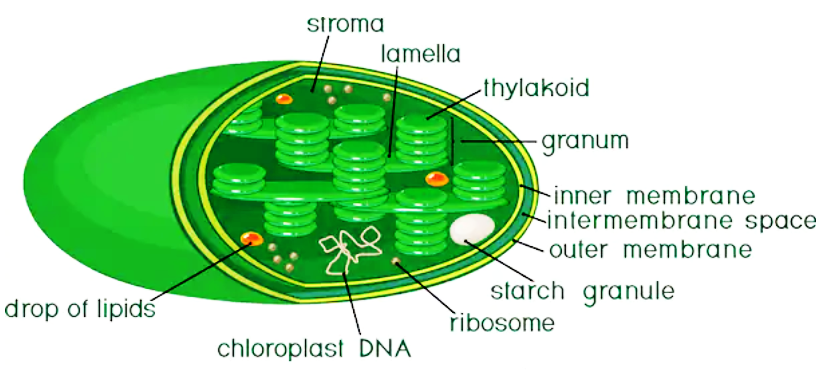
Explain the structure of a chloroplast with the help of a rough diagram.
Answer
486.6k+ views
Hint: Chloroplasts are green coloured plastids which function as the site of photosynthesis in eukaryotic photoautotrophs. They are mostly found in the cells of the mesophyll in plant leaves along their walls for easy diffusion of gases and receiving optimum quantity of incident light.
Complete answer:
The chloroplast is a structure which is surrounded by two unit membranes of 9-10 mm of thickness. They are separated from one another by a space called periplast ideal space. Internally there are two distinct regions of a chloroplast known as the grana and stroma. Grana are made up of aggregation of disc-shaped structures known as thylakoids. The grana of the chloroplast consist of chlorophyll pigments and are the sites for the light reactions. Stroma or matrix is the homogenous matrix which comprises grana and is similar to the cytoplasm in cells in which all the cell organelles are embedded. Stroma also contains various enzymes, DNA, RNA, ribosomes, and other substances. Stroma lamellae helps in connecting the stacks of thylakoid sacs.
The chloroplast structure consists of the following parts that are as follows:
> Membrane Envelope
It comprises inner and outer lipid bilayer membranes. The inner membrane divides the stroma from the intermembrane space. It is a semi-porous membrane which means it is permeable to small molecules and ions, that diffuses easily. The outer membrane of the chloroplast envelope is not permeable to larger proteins.
> Intermembrane Space
It is usually a thin inner-membrane space about 10-20 nm and it is located between the outer and the inner membrane of the chloroplast.
> Stroma
Stroma is an alkaline, colourless, aqueous, protein-rich fluid which is present within the inner membrane of the chloroplast.
> Thylakoid System
This system is suspended in the stroma. It is an aggregation of membranous sacs called thylakoids. Chlorophyll, the green coloured pigments are found in the thylakoid membranes. It is the sight for the light-dependent reactions of the photosynthesis. The thylakoids are arranged to form stacks of discs known as grana and each granum contains around 10-20 thylakoids.

> Chlorophyll
It is a green coloured photosynthetic pigment that assists in the process of photosynthesis.
Note: Chloroplasts are considered as the site of photosynthesis in eukaryotic cells. They are chiefly found only in photosynthetic cells like plant cells and algae. No chloroplasts are found in animal or bacterial cells.
Complete answer:
The chloroplast is a structure which is surrounded by two unit membranes of 9-10 mm of thickness. They are separated from one another by a space called periplast ideal space. Internally there are two distinct regions of a chloroplast known as the grana and stroma. Grana are made up of aggregation of disc-shaped structures known as thylakoids. The grana of the chloroplast consist of chlorophyll pigments and are the sites for the light reactions. Stroma or matrix is the homogenous matrix which comprises grana and is similar to the cytoplasm in cells in which all the cell organelles are embedded. Stroma also contains various enzymes, DNA, RNA, ribosomes, and other substances. Stroma lamellae helps in connecting the stacks of thylakoid sacs.
The chloroplast structure consists of the following parts that are as follows:
> Membrane Envelope
It comprises inner and outer lipid bilayer membranes. The inner membrane divides the stroma from the intermembrane space. It is a semi-porous membrane which means it is permeable to small molecules and ions, that diffuses easily. The outer membrane of the chloroplast envelope is not permeable to larger proteins.
> Intermembrane Space
It is usually a thin inner-membrane space about 10-20 nm and it is located between the outer and the inner membrane of the chloroplast.
> Stroma
Stroma is an alkaline, colourless, aqueous, protein-rich fluid which is present within the inner membrane of the chloroplast.
> Thylakoid System
This system is suspended in the stroma. It is an aggregation of membranous sacs called thylakoids. Chlorophyll, the green coloured pigments are found in the thylakoid membranes. It is the sight for the light-dependent reactions of the photosynthesis. The thylakoids are arranged to form stacks of discs known as grana and each granum contains around 10-20 thylakoids.

> Chlorophyll
It is a green coloured photosynthetic pigment that assists in the process of photosynthesis.
Note: Chloroplasts are considered as the site of photosynthesis in eukaryotic cells. They are chiefly found only in photosynthetic cells like plant cells and algae. No chloroplasts are found in animal or bacterial cells.
Recently Updated Pages
Master Class 11 Economics: Engaging Questions & Answers for Success

Master Class 11 Business Studies: Engaging Questions & Answers for Success

Master Class 11 Accountancy: Engaging Questions & Answers for Success

Master Class 11 English: Engaging Questions & Answers for Success

Master Class 11 Computer Science: Engaging Questions & Answers for Success

Master Class 11 Maths: Engaging Questions & Answers for Success

Trending doubts
Why was the Vernacular Press Act passed by British class 11 social science CBSE

Name the nuclear plant located in Uttar Pradesh class 11 social science CBSE

What steps did the French revolutionaries take to create class 11 social science CBSE

One Metric ton is equal to kg A 10000 B 1000 C 100 class 11 physics CBSE

How did silk routes link the world Explain with three class 11 social science CBSE

Difference Between Prokaryotic Cells and Eukaryotic Cells




